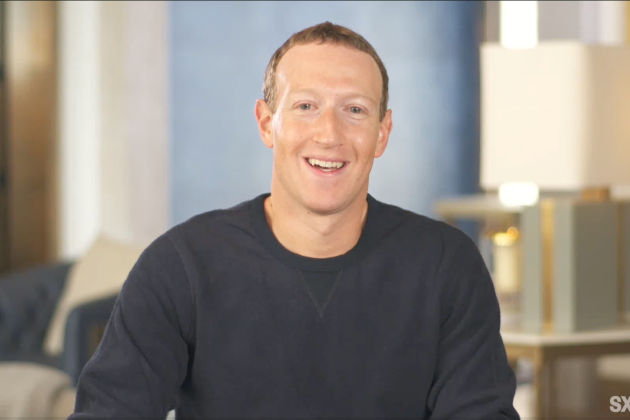WWDownload: 10 Takeaways From Zuck’s SXSW Drive-by
- Oops!Something went wrong.Please try again later.

The metaverse center of gravity shifted to Austin this week, and the tremors must have rippled all the way out to Menlo Park, Calif. Because something moved Mark Zuckerberg to materialize at SXSW, even though he wasn’t originally slated to appear.
Added to the festival’s slate two days after it opened, the bonus session featured the digital talking head of MetaMate Prime (not his official title) for an onstage video chat Tuesday afternoon with Fubu founder and “Shark Tank” star Daymond John.
More from WWD
Inside the SXSW 2022 Opening Scene: Chanel, Gucci, and Sheryl Crow
2020 Holiday Gift Ideas: Google's Top Searched Beauty, Home and Tech Gifts
As Meta’s chief executive officer (his actual title), Zuckerberg dished on the company’s thinking and vision for the metaverse, in a string of broad-ranging comments that may seem familiar to tech-heads and industry insiders, but fascinating for the commercial and cultural mix of creatives and brands at the festival.
Here are the top takeaways and comments from the conversation:
Instagram will support NFTs, and not just as a trophy case.
“We’re working on bringing NFTs to Instagram in the near term. I’m not ready to announce exactly what that’s going to be today. But over the next several months, the ability to bring some of your NFTs in [and], hopefully over time, be able to mint things within that environment.”
Meta is not building the metaverse.
“Just like you wouldn’t say that Facebook was building an internet before, I don’t think you’d say that Meta is building a metaverse.” It’s developing tools for others to build all the different experiences for it.
Fashion will be an important part of it.
“You care about the clothing that you wear when you’re on videoconference. And I think similarly, you’re going to care about how you express yourself on both the avatar and the clothing that you’re wearing with that avatar. So I think there’s going to be a really vibrant economy.”
Zuckerberg envisions users shopping metaverse stores, among many other activities in the virtual world.
Metaverse fashion hinges on interoperability.
“I think it’s really important, as you go from one experience to the next, that you can bring your sweater or your jacket, or whatever it is that you want, to express yourself. It’s just a lot less useful if everything that you buy is constrained to one app or one game, and that’s going to really inhibit the creator economy. And that’s where some of the Web3 stuff … comes in.”
Meta gives Web3 the big thumbs up …
Web3 refers to collective blockchain services, in a version of the metaverse that no one particular company or group controls. Not even Meta, and it’s supposedly fine with that.
“That really allows to build some of the infrastructure to make some of these metaverse experiences more decentralized and interoperable over time, and we really want to lean into that. Because I think that trend of being able to kind of express yourself and bring your stuff with you, across all these different experiences, is just going to be so important to this creative economy reaching its full potential here.”
… as well as Roblox, Epic Games and others.
Meta isn’t trying to compete with metaverse gaming platforms — it wants to work with them, according to the CEO: “I think Epic is doing great work. I think Roblox is doing great work.… Those are companies that we hope to work with on standards, to make sure that all this stuff becomes interoperable.”
Fitness will probably drive a lot of people to the metaverse.
He sees a range of reasons to go in, from work to socializing and entertainment. But he’s intrigued by fitness: “It was a little surprising to me initially but it kind of makes sense right? Instead of buying a you know, an expensive Peloton bike and having a subscription to that, you can just use your Quest headset and get a subscription to Supernatural and do boxing classes. Right? So that kind of makes sense for fitness. I think you’ll see that.”
Photorealistic avatars will be a thing. Eventually.
“There’s going to be this spectrum from photorealistic … maybe if you’re in a formal business meeting or something in the future, rather than doing a video chat, you’ll just put on a headset, whether it’s a VR headset, or AR glasses, and someone can show up as a hologram on your couch or around your table.”
It will take years to fully build out the metaverse.
Building out 5G cellular networks and other infrastructure will take more time and coordinated effort. He sees Ray-Ban Stories-like devices sporting advanced augmented reality features like Microsoft’s HoloLens someday, but it will take years, he said. Other parts of the metaverse may come sooner.
In the meantime, avatars will keep getting better, and so will ways to shop and dress them.
“There’s a lot of stuff that’s not just on the pure technology side, but [developing], so that you can have a creator marketplace of clothing, and that you can have it be decentralized and interoperable through NFTs,” he said. “I hope that that will come within the next few years, too, at sort of a larger scale.”
Sign up for WWD's Newsletter. For the latest news, follow us on Twitter, Facebook, and Instagram.
